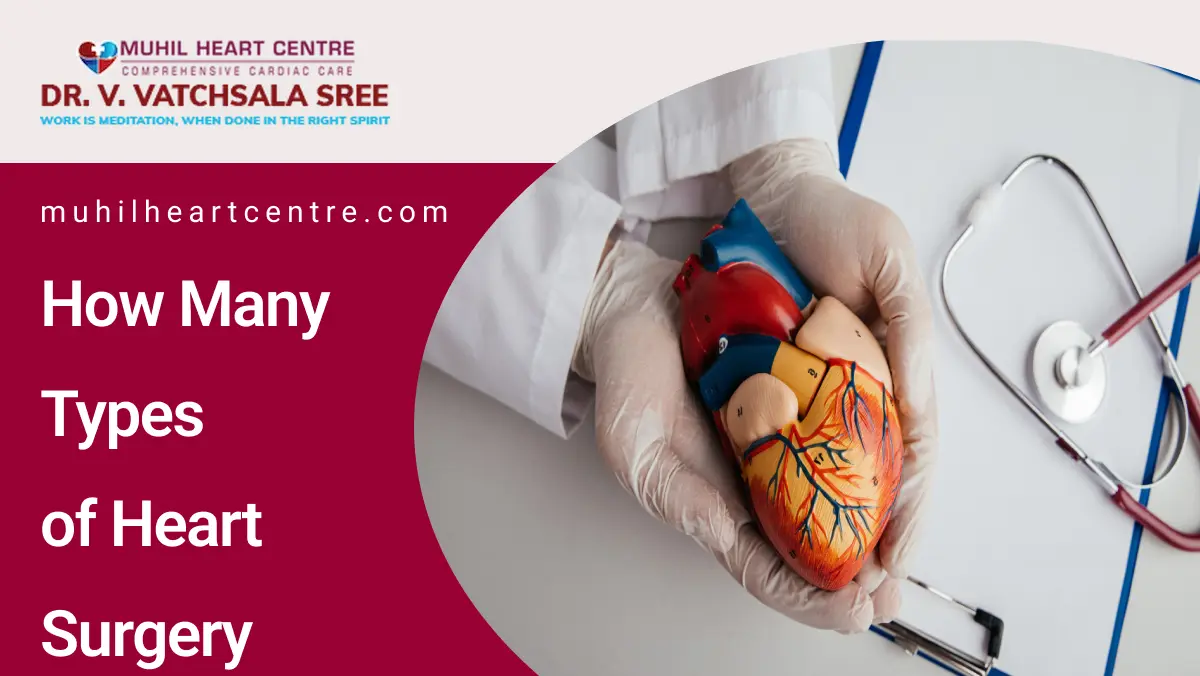Heart surgery, also known as cardiac surgery, is a medical procedure used to treat a variety of heart-related conditions. These procedures are often life-saving and can significantly improve a patient’s quality of life. In this article, we will delve into the world of how many types of heart surgery, and how they can help individuals with heart conditions.
Types of Heart Surgery
If you’re wondering, how many types of heart surgery are there and which surgery is best for heart blockage, the answer is that there are several, each tailored to address different cardiac issues and help individuals lead healthier, more fulfilling lives.

Coronary Artery Bypass Grafting (CABG)
One of the most common types of heart surgery is Coronary Artery Bypass Grafting (CABG), often abbreviated as CABG. This procedure is performed to treat coronary artery disease (CAD), where the blood vessels supplying the heart muscle become narrowed or blocked. During CABG, a surgeon takes a healthy blood vessel from another part of the body, usually the leg or chest, and uses it to create a bypass around the blocked coronary artery, restoring proper blood flow to the heart.
Heart Valve Repair or Replacement
Heart valve surgery is another category of heart surgery. It involves repairing or replacing one or more of the heart’s four valves: the aortic valve, mitral valve, tricuspid valve, and pulmonary valve. These valves can become damaged due to various factors, including congenital defects, infection, or age-related degeneration. Surgeons may repair a valve by reshaping it or replace it with a mechanical or tissue valve.
Pacemaker Implantation
When you get to know how many types of heart surgery are there, you should know that pacemaker implantation is also a procedure that is used to install a small electronic device called a pacemaker, which helps regulate the heartbeat. It is often used to treat conditions such as bradycardia (slow heart rate) or arrhythmias (irregular heart rhythms). The pacemaker emits electrical impulses that stimulate the heart to beat at a normal rate, ensuring adequate blood flow throughout the body.
Aneurysm Repair
Aneurysm repair surgery is performed to treat aneurysms, which are abnormal bulges or weak spots in the walls of blood vessels. When an aneurysm occurs in the aorta, the largest artery in the body, it can be particularly dangerous. Two common approaches for aneurysm repair are open surgery and endovascular repair, depending on the location and size of the aneurysm.
Heart Transplant
In cases of severe heart failure where other treatments are ineffective, a heart transplant may be the only option. You have to understand how many types of heart surgery are there along with heart transplant because this intricate procedure involves removing a failing heart and replacing it with a healthy donor heart. Heart transplants can significantly extend a patient’s life and improve their overall well-being. However, finding a suitable donor match is a complex process.
Ventricular Assist Device (VAD) Implantation
A Ventricular Assist Device is a mechanical pump implanted in the chest that assists the heart in pumping blood to the rest of the body. It is often used as a bridge to transplant for patients awaiting a heart transplant or as destination therapy for those who are not eligible for transplant. VADs can be used to support the left, right, or both ventricles of the heart, depending on the patient’s condition.
Maze Procedure for Atrial Fibrillation
Atrial Fibrillation (AFib) is an irregular and often rapid heartbeat that can increase the risk of stroke and other heart-related complications. When considering how many types of heart surgery are available, one procedure that addresses AFib is the Maze procedure. This surgical treatment for AFib creates a pattern of scar tissue in the heart to disrupt abnormal electrical signals and restore a normal rhythm. It is worth noting that the Maze procedure is often performed in conjunction with other heart surgeries.
Which Surgery is Best for Heart Blockage?
The decision regarding which surgery is best for heart blockage depends on several factors, including the location and severity of the blockage, the patient’s overall health, and the presence of other underlying heart conditions. When considering the best surgery for heart blockage, there are two common surgical procedures that come into focus: coronary artery bypass grafting (CABG) and percutaneous coronary intervention (PCI), also known as angioplasty with stent placement.
Here’s a brief overview of both procedures:
Coronary Artery Bypass Grafting (CABG)
CABG is a surgical procedure that is often considered when multiple coronary arteries are significantly blocked or if the blockages are in locations that are not suitable for angioplasty and stent placement. During CABG, a surgeon takes a healthy blood vessel, usually from the leg or chest, and grafts it onto the blocked coronary artery to bypass the blockage. This creates an alternative pathway for blood to flow to the heart muscle, restoring blood flow and oxygen supply. When a surgeon discusses how many types of heart surgery are there, the surgeon will also explain about CABG as it is particularly effective for addressing complex blockages involving multiple vessels.
Percutaneous Coronary Intervention (PCI) with Stent Placement
PCI, or angioplasty, is a less invasive procedure than CABG. During PCI, a catheter with a balloon at its tip is inserted into the blocked coronary artery. The balloon gets inflated to widen the artery and compress the plaque, restoring blood flow. In many cases, a stent (a small mesh tube) is also placed in the artery to keep it open. PCI is suitable for single or less severe blockages and is typically performed when the blockage is located in a large or accessible coronary artery.
Conclusion
To conclude, besides knowing how many types of heart surgery, it is crucial to understand that heart surgery encompasses a wide range of procedures. Each procedure is designed to address specific heart conditions and improve the overall health and well-being of patients. From bypassing blocked arteries to repairing or replacing damaged valves, these surgeries play a crucial role in treating heart disease and extending lives.


